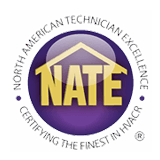
A furnace is usually a background player at home, keeping you warm during the cold winter months. It often won't be noticed until a malfunction appears.
One cause could be that your furnace has a cracked heat exchanger. It’s a potentially dangerous issue, so it’s important to know the signs of a cracked heat exchanger and what you can do if you believe that may be the problem.
What Is a Heat Exchanger in a Furnace?
A heat exchanger transfers heat from the combustion chamber in your furnace to the air that circulates throughout the system. It typically handles this using coils or tubes that warm the air while serving as a barrier to keep the gasses formed in the combustion chamber, called flue gasses, from escaping out into your home.
Is a Cracked Heat Exchanger Dangerous?
Given its important role, it isn't surprising that a broken heat exchanger can pose a risk. A crack in the heat exchanger can allow dangerous gasses – like carbon monoxide, which can be lethal – to circulate throughout your home.
For that reason, don't ever turn on your furnace if you suspect there's a crack in the heat exchanger, as this could make the entire family sick. Contact an HVAC professional as soon as possible if you think your furnace has a cracked heat exchanger that needs to be repaired.
Four Signs of a Cracked Heat Exchanger:
- Furnace shuts off: Cracks in the heat exchanger can cause your furnace to turn off.
- Odd Smells: If the air coming out of your furnace has an intense chemical odor, it could be an indicator that gasses are leaking through cracks in your heat exchanger. These gasses, which may smell like formaldehyde, are a major warning sign.
- Carbon monoxide alarm goes off or you feel poisoning symptoms: If a cracked heat exchanger is emitting carbon monoxide into your home, your carbon monoxide alarm should go off or family members may experience signs of carbon monoxide poisoning. Side effects include headaches, dizziness, weakness, nausea, vomiting or feeling drowsy. If an alarm goes off or you feel unusually tired, get out of the home as soon as you can and then call for help.
- Soot: If you notice black sooty accumulating on the exterior of your furnace, it’s more evidence something may be seriously wrong.
What You Should Do if a Furnace Heat Exchanger is Cracked
If you believe your furnace has a cracked heat exchanger, call a professional well versed in furnace installation Elk River right away so they can inspect your system and, if needed, handle a furnace heat exchanger replacement. Costs will fluctuate depending on the situation, but estimates can roughly suggest $1,000 to $3,000.
However, the good news is that heat exchangers are regularly covered by the warranty. You’ll want to review the warranty paperwork on your furnace, since while the warranty won't always cover the entire cost of repairs, it could significantly lower your bill.
How to Avoid a Cracked Heat Exchanger in Your Home
One of the easiest ways to avoid problems in your furnace overall is with regular furnace maintenance. Furnaces offer the most benefits when they operate efficiently. Hiring a trained professional to examine your furnace for worn-out parts, clogs in the air filters and other common problems can help you avoid getting a big bill later on.
It’s also helpful to review your furnace filters every few months – it’s encouraged some filters be replaced every 90 days or sooner if they are dirty or grimy. While the filters aren't a part of the heat exchanger itself, the strain of pulling air through a clogged filter makes the entire furnace work more vigorously to complete its job. And the harder your furnace has to work, the more wear and tear pieces like the heat exchanger will sustain.

